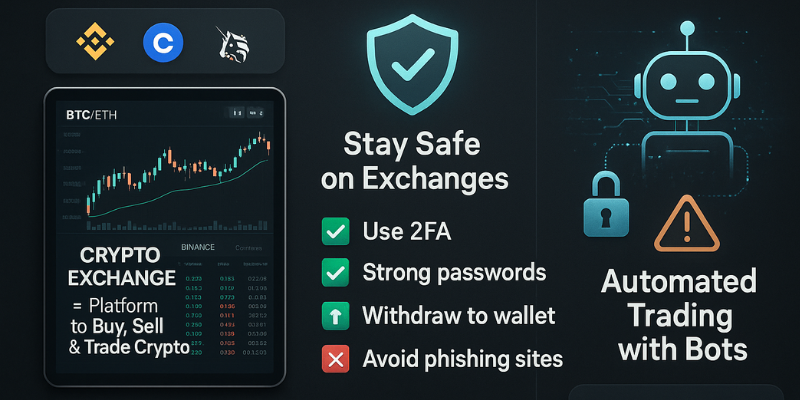If you’re exploring crypto trading, one of the first things you’ll need is a reliable crypto exchange. Whether you plan to trade manually or test out automated trading using a crypto trading bot, picking the right exchange—and staying safe—is essential.
Let’s break it down and tie it to modern crypto trading practices like using trade bots.
What is a crypto exchange?
A crypto exchange is a website or platform where you can buy, sell, or trade cryptocurrencies and tokens. Think of it like a stock market—but instead of trading shares of Apple or Tesla, you’re trading digital assets like Bitcoin, Ethereum, or thousands of other coins and tokens.
On a crypto exchange, you can:
✅ Buy crypto with cash or stablecoins
✅ Trade crypto for fiat currencies like USD or EUR, or for other cryptos
✅ Trade crypto pairs (e.g. BTC/ETH, ETH/USDT)
✅ Use advanced tools, including trading bots for automated crypto trading
Some exchanges also offer services like lending, staking, and integrations with crypto trading bots for automated strategies.
Types of crypto exchanges
Centralized exchanges (CEX)
- Run by a company
- Custodial: the exchange holds your funds and private keys
- Examples: Binance, Coinbase, Kraken
Decentralized exchanges (DEX)
- Peer-to-peer trading with no central authority
- Non-custodial: you keep control of your private keys and funds
- Examples: Uniswap, PancakeSwap
Centralized or decentralized: which should you use?
- Beginners → CEX: Easier to use, higher liquidity, and better integration with trading bots
- Advanced users → DEX: Greater privacy and control, but requires more technical knowledge
Many traders use a mix of both depending on their crypto trading strategy and goals.
Read more about CEX and DEX.
How to use a crypto exchange safely
Whether you’re trading manually or using a cryptobot, security should be your top priority. Here’s how to protect yourself:
1. Choose a reputable exchange
- Look for exchanges with a solid security track record
- Check for regulatory compliance where applicable
- Read user reviews and community discussions before depositing funds
2. Enable two-factor authentication (2FA)
Always activate 2FA to add an extra layer of protection. Even if someone steals your password, 2FA helps block unauthorized access.
3. Use strong, unique passwords
- Never reuse passwords from other sites
- Consider using a reputable password manager to keep your credentials safe
4. Withdraw funds to your own wallet
If you’re not actively trading, transfer your crypto to a non-custodial wallet for greater security. Remember the golden rule: Not your keys, not your coins.
5. Watch out for phishing scams
- Always double-check URLs
- Hackers often create fake websites that mimic real exchanges to steal login details
6. Start small and test first
If you’re new to automated trading or experimenting with a trading bot, start with small amounts. Test the system thoroughly before committing larger sums.

Crypto exchanges and bots for trading
Modern crypto trading often involves automation. Many exchanges:
✅ Offer APIs for connecting crypto trading bots
✅ Support automated strategies like grid trading, scalping, and arbitrage
✅ Allow cryptobots to scan prices and execute trades 24/7
Tip: Link your trader bot only to reputable exchanges, and use API keys with limited permissions (e.g. “trade only,” no withdrawal access).
Final thoughts
A crypto exchange is your gateway to crypto trading, cryptocurrencies, and tokens. Whether you’re making manual trades or running a crypto trading bot, security comes first:
✅ Research your exchange thoroughly
✅ Practice strong security habits
✅ Understand the risks of custodial vs. non-custodial platforms
With the right knowledge, you can confidently explore crypto trading platforms, develop sophisticated trading strategies, and even leverage advanced tools like crypto trading bots—all while keeping your funds safe.

